



Our times are characterized by the accelerating collapse and redrawing of multiple borders: between nation states, personal identities, and the responsibilities we have for each other. Also between the old distinctions, work and pleasure.
Some leaders as part of the new world order, tell us through their political actions and their fashion accessories, that they “Just Don’t Care”. This “political art-form”1 of not caring permits an insidious spread of hatred online and on the ground. In recent times, the digital condition has lent it’s networks and platforms to this poisonous, rhetorical hyperbole, turning against immigrants, and others who do not fit into the framework of a western world, oligarch orientated vision. Mass extraction and manipulation of social data has facilitated the circulation of fake news and the production of fear, anxiety and uncertainty. Together these fuel the machine of structural violence adding to the already challenging conditions created by Austerity policies, growing debt and poverty.
In the face of these outlandish difficulties our digital tools and networks – taken up with a spirit of cultural comradeship. More inspiring narratives are emerging from across disciplines and backgrounds, to experiment with new solidarity-generating approaches that critique and build platforms, infrastructures and networks, offering new possibilities for reassessing and re-forming citizenship and rights.
The exhibition and labs for Playbour – Work, Pleasure, Survival, have created new contexts for collaboration. Artists (from the local area and internationally), game designers and architects, come together with researchers from psychology and neuroscience addressing the data driven gamification of life and everything.
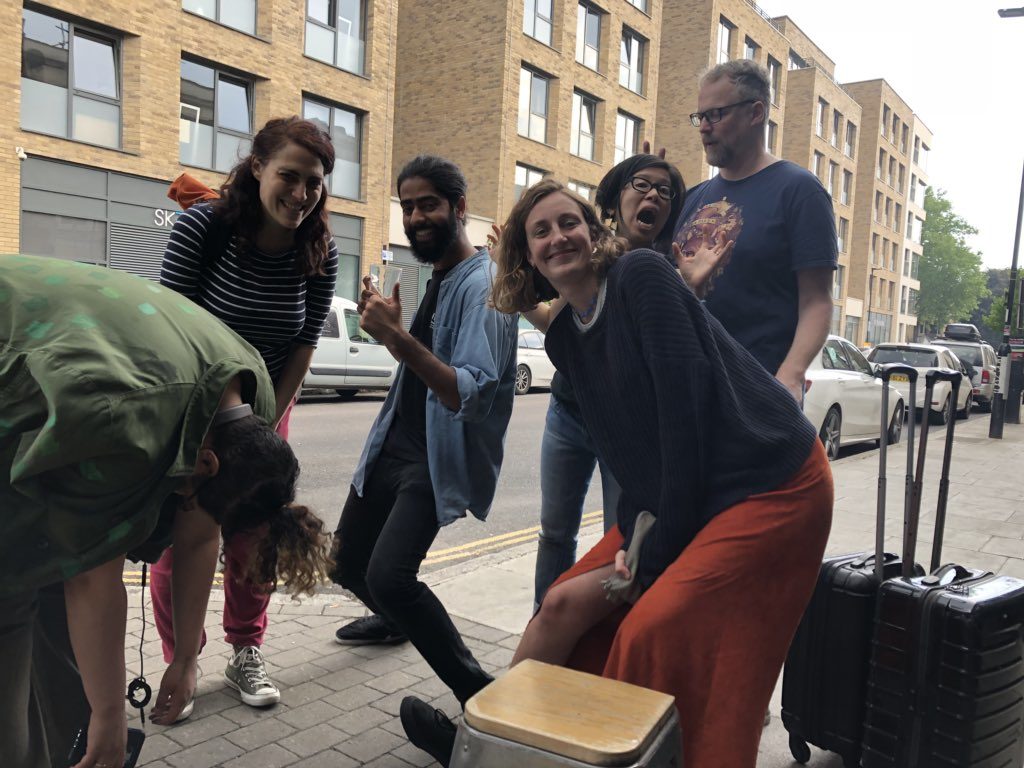
In her interview, the curator Dani Admiss discusses how they reassess the power relationships of the gallery, park users and the local authorities, asking who owns the cultural infrastructure and public amenities – and so create a polemic to open up questions of public value. The exhibition is open every weekend through 14 July to 19 August 2018.
The artists featured in Transnationalisms exhibition curated by James Bridle address the effect on our bodies, our environment, and our political practices of unstable borders.
“They register shifts in geography as disturbances in the blood and the electromagnetic spectrum. They draw new maps and propose new hybrid forms of expression and identity.”2

“Thiru Seelan, a Tamil refugee who arrived in the UK in 2010 following detention in Sri Lanka during which he was tortured for his political affiliations, dances on an East London rooftop. His movements are recorded by a heat sensitive camera more conventionally often used to monitor borders and crossing points, where bodies are identified through their thermal signature.”3
The show opens at Furtherfield from September 14th to October 26th 2018, touring as part of State Machines the EU cooperation which investigates the new relationships between states, citizens and the stateless made possible by emerging technologies.
We have another interview with artist and activist Cassie Thornton, where we discuss her current project Hologram, which examines health in the age of financialization, and works to reveal the connection between the body and capitalism. Her interview focuses on a series of experiments that actively counter the effects of indebtedness through somatic – or body – work including her focus on the way in which institutions produce or take away from the health of the artists and workers they “support”.
“In my work for the past decade, I have been developing practices that attempt to collectively discover what debt is and how it affects the imagination of all of us: the wealthy, the poor, the indebted, financial workers, babies, and anyone in-between.” Thornton
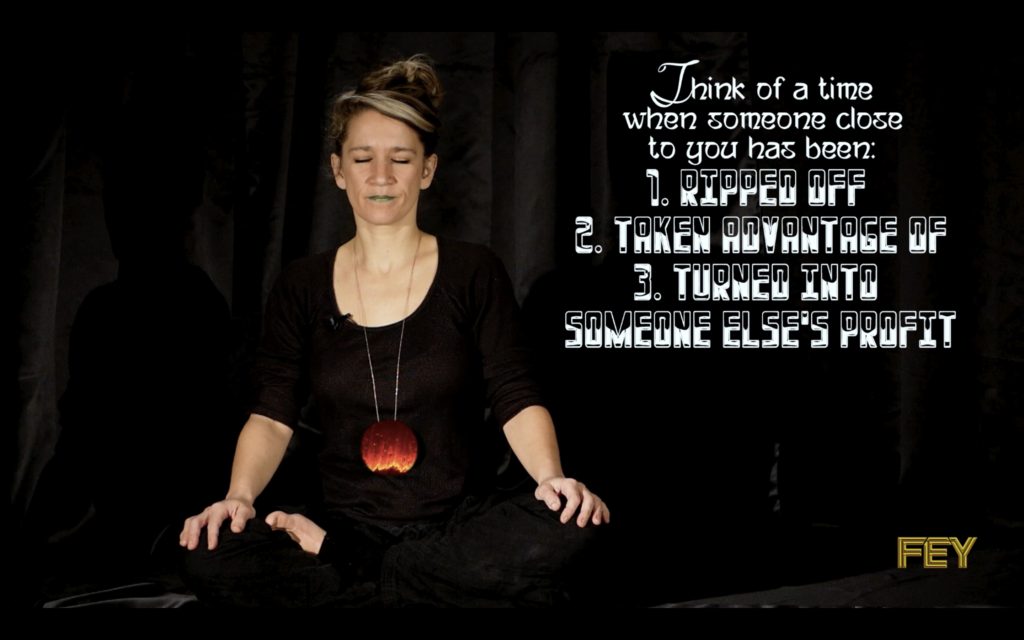
Finally I interview Tatiana Bazzichelli, artistic director and curator of the Disruption Network Lab, in Berlin, questions about art as Investigation of political misconducts and Wrongdoing. Since 2015, the Disruption Network Lab has cultivated a stage and a sanctuary for otherwise unheard and stigmatised voices to delve into and explore the urgent political realities of their existence at a time when the media establishment has no investment in truth telling for public interest.
“When the speakers are with us and open their minds to our topics, I feel that we are receiving a gift from them. I come from a tradition in which communities, networks and the sharing of experience were the most important values, the artwork by themselves.” Bazzichelli.
The programme creates a conceptual and practical space in which whistleblowers, human right advocates, artists, hackers, journalists, lawyers and activists are able to present their experience, their research and their actions – with the objective of strengthening human rights and freedom of speech, as well as exposing the misconduct and wrongdoing of the powerful.
To conclude, all one needs to say is…
“Whether in the variety of human, backgrounds and perspectives, biodiversity or diversity of technologies, coding languages, devices, or technological cultures. Diversity is Proof of Life.” Ruth Catlow, 2018.
Artist and designer Ling Tan talks about the SUPERPOWER! workshop that explored ways to empower young women through a creative exploration of wearable technology in public space.
Last summer, artist and designer Ling Tan worked with young peer leaders from All Change Arts, and the Furtherfield team to devise a project called SUPERPOWER! Finsbury Park. It brought together young women from different walks of life to discuss their relationship with the city. The project explored the ability for technology to bring about female empowerment, and question the participant’s role as female in regards to decision making about our city.
Three common themes by the participants were collectively identified, and linked to a place in Finsbury Park. Using the themes to co-create a series of wearable devices that enabled them to record their subjective perceptions of the city using gesture sensing technology. These were: Cultural diversity and inclusivity in our community; Safety of individuals in the London Borough of Islington and; Wheelchair accessibility around Finsbury Park area
It was all co-scripted and used for an exploration walk, involving the team walking around a specific area of Finsbury Park, performing and recording their subjective experiences using the wearable devices that catalogued their gestures. During the workshop, participants designed body gestures using the wearable technology which track their body gestures and communicate remotely with each other through haptic/audio sensors.
Marc Garrett: Where did the idea for the workshops come from and how did the concept of superpower shape what participants did with your wearable technology.
Ling Tan: In SUPERPOWER! Finsbury Park, the participants were young women aged 15-25 years old and almost all of them have no prior knowledge of electronics and coding. Instead of the workshop being about coding and making, I wanted it to focus on empowerment, challenging them to go beyond their comfort zones. Hence the term “superpower” became a powerful concept to get them to think about technology as a form of superpower that extends their perception into the environment. The idea for the workshop built upon a couple of projects I was doing over the past few years; WearAQ and Fakugesi Social Wearables. The projects use wearable technology to enable different communities to actively record and map out their relationship with their cities through individual subjective perception in the form of body gestures. For example, perception of air quality in London, UK and perception of safety on the streets in Johannesburg, South Africa.
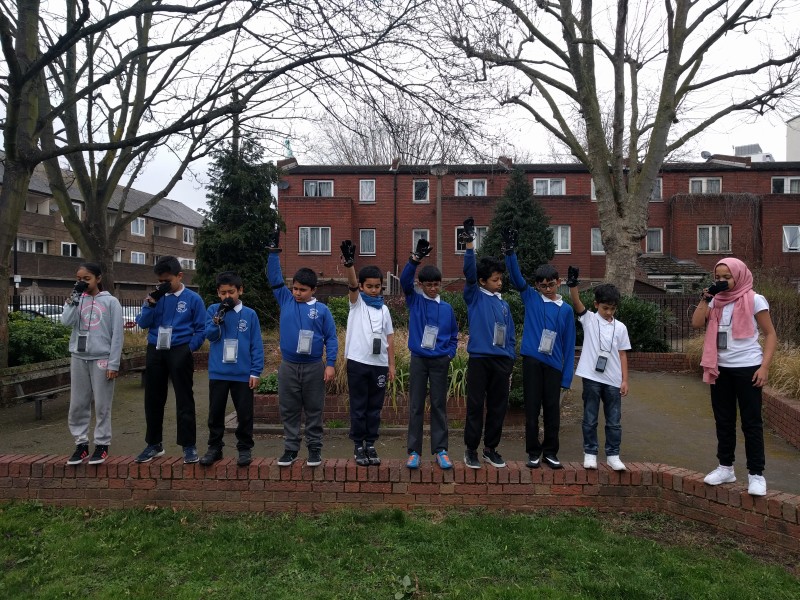

In the workshop, participants discussed about their relationship with Finsbury Park, designed experiments and body gestures to map out their own relationship through the use of an existing set of wearable devices, went out into public space and run with experiments with strangers, park users. For me, learning about what they want to do with technology is more important than picking up skills like coding or fabrication.
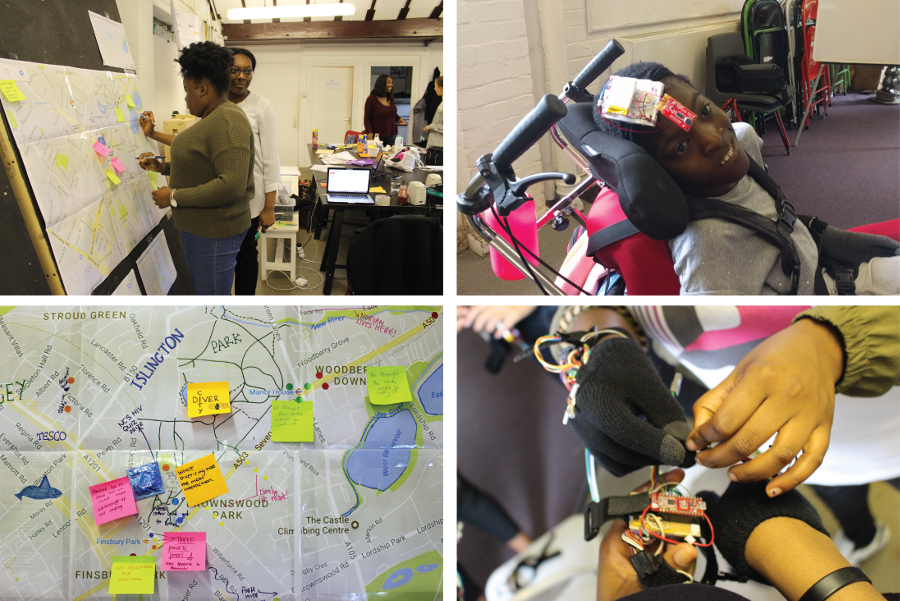
MG: We were surprised to hear how much the young women had appreciated being taught in depth about how the wearable technologies worked as part of this workshop. Do you think this informal workshop format offers a different way of supporting learning about and working with technology? What most surprised you about the way that the young women responded?
LT: I wanted to steer away from a conventional technology workshop where participants would focus on coding and fabrication, than design, because these are skills that they can pick up themselves through on-line documentation and support. For me, what is more important is to figure out what their own interests are with technology, by learning it through hands on design activities with ready made wearable technology. That way, it makes them feel comfortable with tackling complex technology and it also gives them the opportunity to learn about issues that might occur when technology is tested in the real world, checking it out when it does not work and why.

I was most astonished by their speed of learning and how well they picked up the tech knowledge. For example, one part of the workshops involved learning about the body gesture and what the wearables can detect through decoding “1” and “0” read via the body gesture sensors. I was very surprised that they were able to quickly translate that into their own body gesture design.
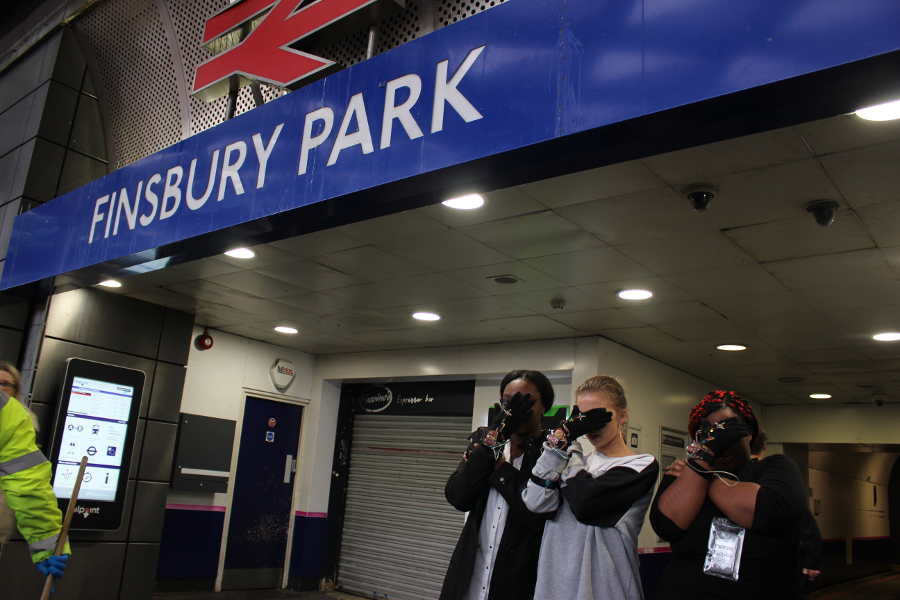
MG: Your workshop addressed questions of value in technology innovation, in the particular context of working in the public space of the park. Please tell us about how you approached these questions and why this is important to you.
LT: I think its is important to demystify technology especially given that we are living in an era where technology is so embedded into our everyday life that we take it for granted and do not notice its impact. It is important for the younger generation to learn about ethics of technology, to be curious about who and why companies are designing specific types of technology, and most importantly, to learn that technology does not always work, that technology cannot solve all our problems. They need to learn to be proactive and have a sense of agency in tackling issues concerning their own environment. For example, issues such as safety on the streets cannot be solved entirely by technology, it also needs other input such as citizen vigilance, policy and law changes.
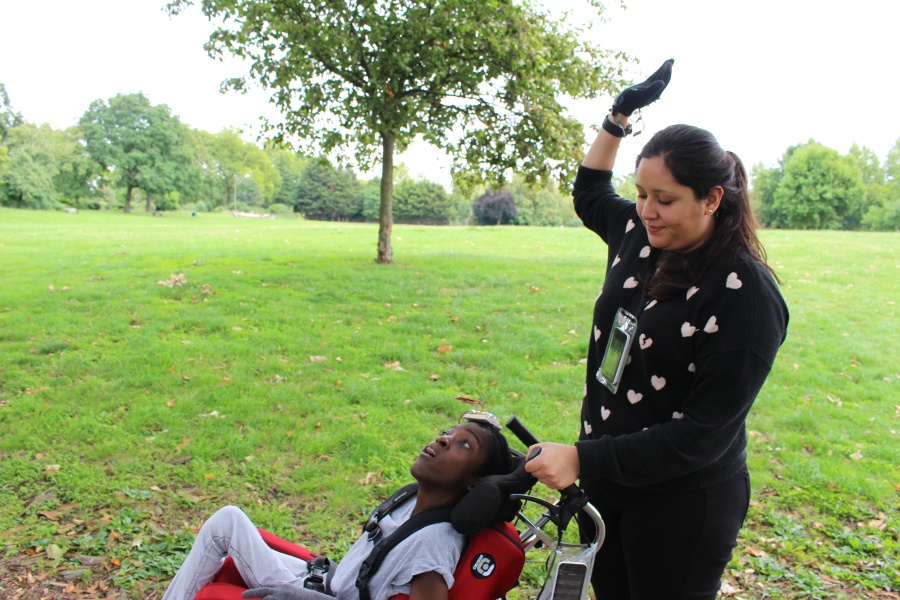
SUPERPOWER! Finsbury Park was a part of the B Creative Summer School, a programme of arts projects created by young women for young women aged 16 – 25 in Islington.
Special thanks to:
All the participants involved in the project
Peer leaders from All Change
Ella Medley Whitfield
Commissioned and supported by: Furtherfield and All Change
This project has been funded with the support from the European Commission. This communication reflects the views only of the author, and the Commission cannot be held responsible for any use which may be made of the information contained therein.
FREE Exhibition Tour and Artists Talk: Sat 18 June, 2-4pm
DOWNLOAD PRESS RELEASE (.pdf)
SEE IMAGES FROM ACCOMPANYING EVENTS
Featuring Gretta Louw, Lily Hibberd, Brook Andrew, Curtis Taylor, Jenny Fraser, Sharon Nampijinpa Anderson and the Warnayaka Art Centre.
Networking the Unseen is the first exhibition of its kind to focus on the intersection of indigenous cultures and zeitgeist digital practices in contemporary art.
While digital networks manifest physically as tonnes of cabling, and electrical or electronic devices, the social and cultural impacts of the networks remain somehow invisible, eroding clearly felt boundaries of geography, place, culture and language.
Together with artist and curator Gretta Louw, Furtherfield presents an exhibition and event series that brings together concepts and experiences of remoteness and marginalised cultures, with art-making in contemporary society.
Five culturally and geographically disparate Australian artists – Gretta Louw, Jenny Fraser, Lily Hibberd, Brook Andrew, and Curtis Taylor – and artists, including Neil Jupurrurla Cook, Isaiah Jungarrayi Lewis, and Sharon Nampijinpa Anderson from the Warnayaka Art Centre in Central Australia, present work situated at the intersection between avant garde digital, media, and installation art, the sociological study of digital and networked culture, and activism.
Networking the Unseen proposes a radical rethinking of widely accepted stereotypes concerning the impact of networks on contemporary global cultures, digital art, the avant garde, and indigenous art-making.
It tackles subjects ranging from digital colonialism and cultural marginalisation (or, conversely, diversity/empowerment) within an increasingly connected, online world to universal concerns around cultural change as a result of technological migration.
The exhibition extends our focus to the extremities of the global digital network. It subtly proposes ways to claim power back from centralising forces of control to use these tools for positive change; for intercultural exchange and empowerment for marginalised communities.
The Phone Booth Project, by Paris-based Australian artist Lily Hibberd and Martu indigenous filmmaker and artist Curtis Taylor, is a multimedia installation that demonstrates the intricate relationship between community and technology and how this is uniquely affected by local circumstance and environmental factors. Phone booths have all but died out in urban environments, and yet this beautiful and nuanced work, created in the Western Desert region of rural Australia with the indigenous Martu communities, highlights the vital role that they continue to play at the edges of the network – where cell phone reception is often non-existent, and landline phone connections in every house are an infrastructure expense that neither the locals nor the government is willing or able to carry.

Brook Andrew is an internationally recognised Australian artist whose practice in installation, print, neon, and performance often draws on his Wiradjuri indigenous heritage. In Costumes for the Cell (2012) Andrew’s instantly recognisable digitally-facilitated contemporary revision of a traditional Wiradjuri pattern – a powerful example of the blending of old and new culture; tradition and technology – becomes a moving installation as it is worn by performers at the opening.
Gretta Louw’s ongoing collaboration with artists from the Warnayaka Art Centre has produced the two video works Digital Desert and Is the Desert Still the Desert in a Digital World? in 2012, followed in 2014 by the YAMA project – an immersive, on-site multimedia installation built in the remote central Australian desert. The immersive installation at Furtherfield manifests the physical installation in wall paintings, screens, and light. It invites us to explore the nature of cultural change brought about by the arrival of advanced digital technologies.

Name That Beach, a video work by a fore-runner of the indigenous digital art movement Jenny Fraser, is programmed alongside works by emerging artist Curtis Taylor in a fascinating and inspiring insight into contemporary digital media art-making in Australia.

The works in the exhibition invites reflection by non-indigenous audiences on the techno-cultural change within their own society, and their individual relationship to internet technologies.
Exhibition Tour and Artists Talk
Saturday 18 June 2016 – 2-4pm – Furtherfield Gallery & Commons
Join Neil Jupurrurla Cook, artist and Director of the Warnayaka Art and Aboriginal Cultural Corporation, and Gretta Louw, artist and curator, for a curated tour of Networking the Unseen and then head down to Furtherfield Commons for a Show and Tell about their collaboration and work.
FREE – Limited places, booking essential (register)
Free family workshops at Furtherfield Commons
Every Saturday from 23 July to 27 August, 2-4pm
Fun, interactive workshops for local families aged 5 upwards.
Details to be confirmed – Register your interest here
Young digital artists residency at Furtherfield Commons
25 July – 5 August, Monday-Friday, 11am-4pm
Adventures in arts and technology for young people 13-18 living in or attending school in Islington.
Details to be confirmed – Register your interest here
Networking the Unseen – Selfies and Alterity
Thursday 4 August, 6-8pm – Furtherfield Gallery & Commons
6-6.45: Gretta Louw will give a tour of the exhibition Networking the Unseen at Furtherfield Gallery.
7-8 join us at Furtherfield Commons where she will present preliminary work on a Warlpiri (First Nations Australian) selfie and photo editing app, a collaboration with the Warnayaka Art Centre, and discuss the ways in which your emojis are not innocent, digital colonialism, and how selfies, social media, and alterity can be used for social good.
FREE – Limited places, booking essential (register)
Do It With Others – Art and Solidarity in the Age of Networks
Saturday 6 August, 12-5pm – Wysing Poly, Wysing Arts Centre, Bourn, Cambridgeshire.
With Ruth Catlow, Marc Garrett, Gretta Louw, Tim Waterman and They Are Here
This day long symposium explores art as a commons (defined as the cultural and natural resources accessible to all members of a society) in the age of networks and neoliberalism. How can the practices, circulation, appreciation and stewardship of arts be emancipated for all? Exploring tensions between digital inclusion and cultural diversity in the digital global hegemony.
FREE – Limited places, booking essential (register)
Brook Andrew is an internationally acclaimed Australian artist of indigenous (Wiradjuri) and Celtic descent. He has had significant exhibitions at world class institutions like the Museo Nacional Centro de Arte Reina Sofia and the Tate Britain, and been part of numerous international showcases, such as the Asia Pacific Triennial of Contemporary Art and the Asian Art Biennial. Andrew’s practice is intensely research-based, resulting in interdisciplinary works and immersive installations.
Jenny Fraser is a screen-based artist, curator, and educator. Her work utilises popular cultural references as a bridge to challenge viewers’ frames of reference. She redefines the art of curating as an act of sovereignty and emancipation, and founded the groundbreaking cyberTribe online gallery over a decade ago. A Murri of mixed ancestry, Fraser has received many accolades for her trailblazing work, most recently being awarded a prestigious Australia Council Fellowship in 2012 for her project Midden.
Lily Hibberd is an Australian artist and writer, working between Sydney and Paris. Her practice centres on marginalised people and histories and the restoration of memory through interdisciplinary collaborative social practice. Hibberd’s recent project include major exhibitions at the Musée des art et métiers (2015-16), Paris, and Spaced 2: Future Recall for Perth International Arts Festival (2015).
Gretta Louw is a multi-disciplinary artist and writer exploring the potential of art as a means of investigating cultural and psychological phenomena, particularly in relation to new technologies and the internet. Born in South Africa, she grew up in Western Australia and is currently based in Germany. Her work has been exhibited widely – in New York, Berlin, Jakarta, and Tel Aviv, amongst others – including in a number of public institutions such as the Kunstmuseum Solothurn, Stadtgalerie Mannheim, and Kunstverein Ludwigshafen.
Sharon Nampijinpa Anderson is an artist and educator and one of the directors of the Warnayaka Art and Cultural Aboriginal Corporation. Born near Mt Doreen in the Tanami Desert, Nampijinpa holds a degree from Bachelor College in Darwin, Australia has exhibited her art work widely, including at Galerie Yapa in Paris, Cooee Aboriginal Art Gallery in Sydney, and at the Darwin Aboriginal Art Fair. Nampijinpa is passionate about preservation of Warlpiri culture and has been involved in numerous projects to this end, such as the Arts Workers Extension Program in Australia and the production of the 2013 publication Warnayaka Art Centre: Life in the Digital Desert (Ed Gretta Louw).
Curtis Taylor is an emerging Martu Australian filmmaker and video artist. He has had screenings of his work at the National Gallery of Australia, the Fremantle Arts Centre, the Western Australian Museum of Art, and many more public institutions. Taylor is also currently involved in the VR film project, Collisions, which is debuting at the Sundance Film Festival.
Warnayaka Art Centre is a nationally renowned Australian indigenous (Warlpiri) art centre. The centre is home to a number of internationally successful Warlpiri painters including Lily Nungarrayi Hargraves and Molly and Rosie Napurrurla Tasman. Neil Jupurrurla Cook is the lead media and installation artist; he is the Director of the Warnayaka Art and Aboriginal Cultural Corporation and has shown his sculptural and media installations at the Darwin Art Museum.
Furtherfield was founded in 1997 by artists Marc Garrett and Ruth Catlow. Since then Furtherfield has created online and physical spaces and places for people to come together to address critical questions of art and technology on their own terms.
Furtherfield Gallery
McKenzie Pavilion
Finsbury Park, London, N4 2NQ
Visiting Information